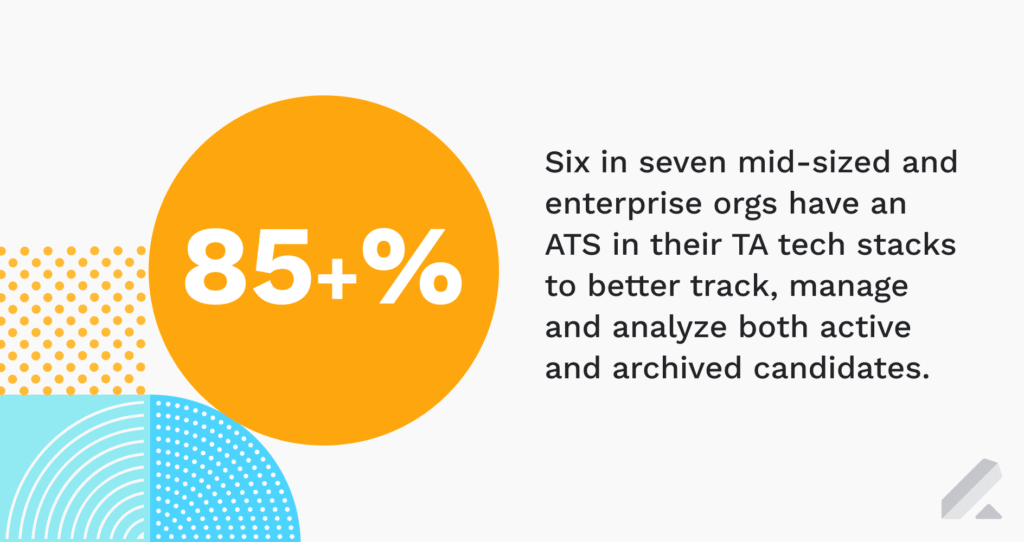As an org scales, sourcing, nurturing, interviewing, and hiring candidates gets more complex.
This is especially true among companies navigating an increasingly fully or partially remote workforce, where traditional recruiting and hiring activities all take place through digital channels like email, phone calls, and video chats.
Businesses that want to continue to deliver stellar candidate experiences need sophisticated technology to optimize those parts of the hiring lifecycle.
Only then can they continue to innovate and stand out to the best candidates.
Fortunately, a new generation of software has emerged that builds on the traditional applicant tracking system (ATS) software function to facilitate important capabilities like automation, personalization, and control for large recruiting teams.
The result is a next-gen talent relationship management (TRM) platform that ensures a seamless experience for candidates and recruiters and a more effective, timely hiring process.
Here’s a look at why the traditional, standalone ATS is no longer sufficient for building real, personalized, and scalable relationships with prospective hires.

What distinguishes a TRM solution from an ATS
An ATS is a database of job applicants and applications that captures and organizes candidate data for tracking and management throughout the recruitment process.
The ATS introduced recruiters to an incredibly efficient way to organize candidate info, allowing them to carefully store and review candidate data all in one place.
But there’s a problem: Recruiters using a “simple” ATS still have to go outside it to search for, email, and schedule interviews with candidates.
This continues to be a problem, especially since the global COVID-19 pandemic pushed the hiring process online for knowledge-sector employees.
Even in the early stages of the application process, it’s incredibly important to build relationships with candidates to stand out in a competitive market.
As Gartner writes in a recent report, “[A]s the TA function in organizations has expanded to compete for talent, TA applications have evolved to cover a broader set of activities such as recruitment marketing, candidate relationship management (CRM) and onboarding.”
That’s where a solution like LeverTRM stands out from old-school, legacy ATS.
Our TRM platform is a solution that offers complete pipeline coverage from source to hire.
This solution delivers unified, real-time insights into creating and strengthening the relationship with potential talent, like LeverTRM’s unique “rediscovery” feature that allows recruiters to revisit previous candidates with whom they have built relationships.
Resurfacing these older candidates can help recruiting staffs with our native talent acquisition suite discern how may be good fits for open and upcoming roles.

How a TRM platform leads to smarter hiring
A TRM functions like an ATS combined with a customer relationship management (CRM) tool, extending beyond simply capturing candidate data. It contains all of the data, activity, and communication surrounding a candidate role in one space.
This centralization helps large recruiting teams gain the oversight and transparency they need to deliver a seamless candidate experience that benefits both candidates and recruiters.
Because the TRM unifies the robust functionality of an ATS and CRM, companies can:
- Scale and grow their “people” pipeline with active and passive candidates
- Build authentic and long-lasting relationships with top prospects of interest
- Hire the right people by leveraging intuitive CRM capabilities and robust analytics
Instead of using the candidate pipeline as a starting point and moving all of the meaningful touchpoints into individual inboxes and recruiter interactions, a TRM gathers all of this important data in one place instead of in fragmented systems.
The functionality of a TRM then allows the talent team to own the candidate experience and incorporate more advanced levels of personalization and automation by candidate and role.
This is also important for implementing recruiting best practices for DEI, as you can view data at each stage of your hiring process in order to identify gaps and track progress.

Why it’s time to move from an ATS to a TRM system
Arguably the biggest difference between ATS software and a TRM solution is the extent to which these tools empower a company’s recruiting team to achieve its goals.
Recruiters today face a lot of pressure to customize and personalize the candidate experience. With an ATS, the burden of delivering that experience falls on the bandwidth of individual recruiters, with little to no oversight.
But with a talent relationship management platform, automation empowers a recruiting team to deliver that personalization at scale while capturing important data in one place at the same time.
“The jump from an ATS to a TRM platform gives recruiters the ability to bring a whole new focus to the candidate experience,” Lever Director of Recruiting Caitlyn Metteer noted.
“It takes the cognitive load of managing the individual pieces of the process off the recruiter so they have more time and energy to invest in the personal side of relationship-building.“
Caitlyn added that, by using a TRM, talent specialists “aren’t checking boxes to push candidates into the right stage.” Rather, they’re automating those touchpoints and spending their time where it really matters: “engaging and interacting with potential candidates.”
Better experience, better results with a TRM
As companies around the world shift into a hybrid working model that incorporates both remote and on-site hiring practices, the difference in functionality between an ATS and a TRM will have an enormous impact on the quality of a company’s candidate experience.
As well as the results of these orgs’ recruiting and hiring efforts.
Recruiters and hiring managers who use a talent relationship management platform — like LeverTRM — to successfully build and manage relationships with remote candidates will have everything they need to secure a warm pipeline of talent, manage that pipeline efficiently, and give candidates a positive interviewing and hiring experience.
Download our in-depth eBook to discover the five talent maturity levels — and how you and your organization can advance from your current ‘stage’ to the next.




